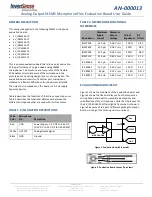
CHAPTER 5: CONTROL CIRCUITRY
5.1 POWER SUPPLY CIRCUIT
You have options on powering PIC32-HMZ144. You can power the board by providing:
•
5V on the mini USB connector
You can power the board from your personal computer via an USB cable; the USB ports of a
personal computer typically provide around 5V of voltage and 500mA of current.
Avoid using USB cables longer than 2 meters. Avoid the cheapest cables with high inner resistance.
•
(3.6 – 4.2)V on the Li-Po battery connector
The board can be powered the board from a Li-Po battery with a fitting connector; a Li-Po battery
typically provides between 3.6V and 4.2V of voltage.
•
3.3V on the ICSP connector
PIC32-HMZ144 can be powered by your debugger (programmer) tool, as long as the tool is capable
of powering targets. You would need to set and enable the powering voltage to 3.3V in the software
options of MPLAB.
•
5V to pin 1 of the EXT2 connector
The board can be powered by external power supply (adapter) capable of providing 5V of voltage.
You should connect the 5V wire to pin #1 of EXT2 connector. You also need to connect the ground
wire to pin #2 of the same (EXT2) connector. The names of the pins are printed at the bottom of the
board.
Different methods of powering would lead to different maximum current available. Consider
powering the board with an external power supply connected to EXT2 if you need extra current (in
case you have to power additional hardware via PIC32-HMZ144).
You can have more than one power supply connected at the same time. Note that the board has
built-in battery charger. If you have another power source connected to the board at the same time
as the battery (for example, USB) – the charger circuit would attempt to recharge the battery. This
would raise the current consumption of the whole board.
With no extra peripherals connected, the board's current consumption is about 100mA at 5V when
running the default demo program.
Page 17 of 26











































